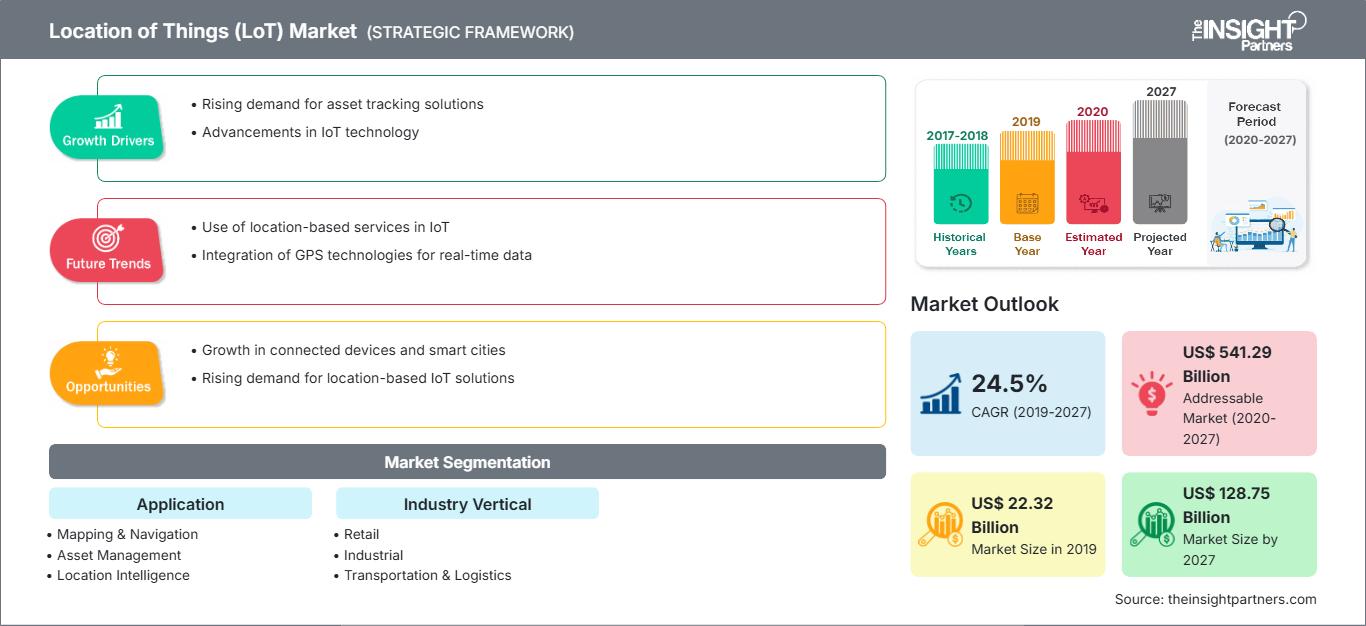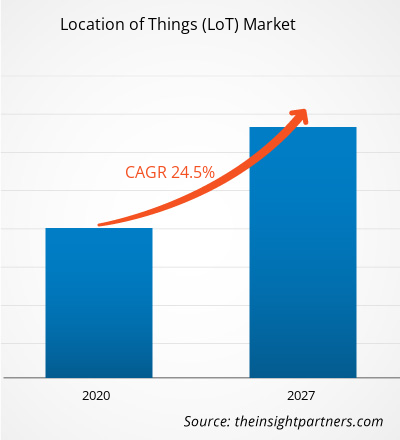The location of things (LoT) market was valued at US$ 22.32 billion in 2019 and is projected to reach US$ 128.75 billion by 2027. The Location of things (LoT) market is expected to grow at a CAGR of 24.5% during the forecast period of 2020 to 2027.
The global internet infrastructure market is experiencing intense growth with regards to the investments for the introduction of new and advanced technologies to have better access over real-time data. The location of things market consists of some well-established players across the globe, which makes significant investments or adopt strategies to deliver highly advanced service to the users. Government funding for research & development, strategic partnerships between service providers, network operators and government bodies are anticipated to enable huge surges in the market for the location of things over the forecast period. The present generation of mobile networks endures to alter the technique people access information and communicate. The implementation of Location of Things for conducting various businesses adds more sense to the available data. The bolstering demand of IoT connectivity, security, mobile data traffic, and expansion of mobile apps lead to the integration of cloud architecture with the mobile networks to enhance the flexible delivery of services with high speed. Marketers can leverage upon the data produced, and sense the consumer demand based on the trends and patters observed.
The market for Location of Things globally has been segmented into two major segments including application and industry vertical. The application segment is further fragmented by Small Cell, macro cell, and others Mapping & Navigation, Asset Management, Location Intelligence, and Media & Marketing. Whereas the industry vertical is further segmented into Retail, Industrial, Transportation & Logistics, Government & Utilities, Defense, Media & Entertainment, Healthcare, and Others. Geographically the Location of Things market is presently dominated by developed regions including, North America. However, the market is expected to be in favor of APAC. The rising penetration of smartphones in the developing economies of Asia coupled with the rapidly developing internet infrastructures in these regions are proving to be the major drivers for the growth in the adoption of Location of Things technology.
Customize This Report To Suit Your Requirement
You will get customization on any report - free of charge - including parts of this report, or country-level analysis, Excel Data pack, as well as avail great offers and discounts for start-ups & universities
Location of Things (LoT) Market: Strategic Insights

-
Get Top Key Market Trends of this report.This FREE sample will include data analysis, ranging from market trends to estimates and forecasts.
Location of Things (LoT) Market Insights
Proliferation of IoT and Connected Devices Over the Network and the Need to Harness Useful Data
Mobile data consumption has witnessed exponential growths in the last few years. On a global level, that data traffic rate has grown at an annual rate of more than 65% over the last five years. Also, between 2018 and 2023, the data traffic is anticipated to grow at a compound annual growth rate of close to 40 percent. As more advanced services and devices emerge, operators need to raise their targeted service quality levels even further. Thus, demand for the location of things (LoT) market will also surge in forecasted period of 2020-2027.
Application -Based Market Insights
The global Location of Things market on the basis of application is categorized into mapping & navigation, asset management, location intelligence, and media & marketing. All the industry sectors use the location based software tools for various purposes. The basic purpose behind using these tools is to organize the data obtained over the internet and put it to meaningful use. Abundant data is available through numerous data points, and the emergence of IoT has just propelled the data explosions. The numerous applications for using location based services are broadly categorized in our study for LoT market.
Industry Vertical -Based Market Insights
The data collected in the LoT model is often taken up from various digital addresses. Thousands of data points encompass the digital address and include IP addresses, social networks, email addresses and GPS coordinates, as well as physical addresses. The geospatial data creates valuable opportunities by creating accurate forecasts for various business verticals. Almost all business verticals have started harnessing the power of geospatial data. In our study for Location of Things market, the market has thus been segmented on the basis of industry vertical into retail, industrial, transportation & logistics, government & utilities, defense, media & entertainment, healthcare, and others
Players operating in the Location of things (LoT) market focus on strategies, such as market initiatives, acquisitions, and product launches, to maintain their positions in the location of things (LoT) market. A few developments by key players of the location of things (LoT) market are:
In February 2019, Skyhook Collaborated with Qualcomm Technologies Inc. a subsidiary of Qualcomm Incorporated, to bring Wi-Fi positioning and location-assistance services based on Qualcomm Snapdragon Wear platforms.
In February 2019, Continual and HERE Technologies collaborated to create a pioneering integrated solution for mobile network operators (MNO), designed to continuously monitor and map the connected experience of users on the move across the entire road network.
Location of Things
Location of Things (LoT) Market Regional InsightsThe regional trends and factors influencing the Location of Things (LoT) Market throughout the forecast period have been thoroughly explained by the analysts at The Insight Partners. This section also discusses Location of Things (LoT) Market segments and geography across North America, Europe, Asia Pacific, Middle East and Africa, and South and Central America.
Location of Things (LoT) Market Report Scope
| Report Attribute | Details |
|---|---|
| Market size in 2019 | US$ 22.32 Billion |
| Market Size by 2027 | US$ 128.75 Billion |
| Global CAGR (2019 - 2027) | 24.5% |
| Historical Data | 2017-2018 |
| Forecast period | 2020-2027 |
| Segments Covered |
By Application
|
| Regions and Countries Covered |
North America
|
| Market leaders and key company profiles |
|
Location of Things (LoT) Market Players Density: Understanding Its Impact on Business Dynamics
The Location of Things (LoT) Market is growing rapidly, driven by increasing end-user demand due to factors such as evolving consumer preferences, technological advancements, and greater awareness of the product's benefits. As demand rises, businesses are expanding their offerings, innovating to meet consumer needs, and capitalizing on emerging trends, which further fuels market growth.

- Get the Location of Things (LoT) Market top key players overview
Location of Things (LoT) Market – by Application
- Mapping & Navigation
- Asset Management
- Location Intelligence
- Media & Marketing
Location of Things (LoT) Market – by Industry Vertical
- Retail
- Industrial
- Transportation & Logistics
- Government & Utilities
- Defense
- Media & Entertainment
- Healthcare
- Others
Location of Things (LoT) Market – by Geography
-
North America
- US
- Canada
- Mexico
-
Europe
- France
- Germany
- Spain
- UK
- Italy
- Rest of Europe
-
Asia Pacific (APAC)
- China
- India
- Japan
- Australia
- Rest of APAC
-
MEA
- Saudi Arabia
- UAE
- South Africa
- Rest of MEA
-
SAM
- Brazil
- Rest of SAM
Location of Things (LoT) Market – Company Profiles
- ESRI
- HERE technologies
- Navizon Inc.
- Qualcomm Incorporated
- skyhook
- Trimble inc.
- Wireless Logic Limited
- Alphabet Inc. (Google)
- Microsoft
- IBM Corporation
- Historical Analysis (2 Years), Base Year, Forecast (7 Years) with CAGR
- PEST and SWOT Analysis
- Market Size Value / Volume - Global, Regional, Country
- Industry and Competitive Landscape
- Excel Dataset
Recent Reports
Testimonials
Reason to Buy
- Informed Decision-Making
- Understanding Market Dynamics
- Competitive Analysis
- Identifying Emerging Markets
- Customer Insights
- Market Forecasts
- Risk Mitigation
- Boosting Operational Efficiency
- Strategic Planning
- Investment Justification
- Tracking Industry Innovations
- Aligning with Regulatory Trends





















 Get Free Sample For
Get Free Sample For